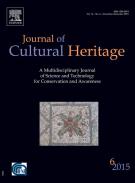Investigating a Byzantine technology: experimental replicas of Ca-phosphate opacified glass - 05/09/19

| pages | 9 |
| Iconographies | 6 |
| Vidéos | 0 |
| Autres | 0 |
Highlights |
• | The glass opacification technique, based on animal bones, is investigated by means of experimental replicas. |
• | A single piece of bovine bone was selected and mixed with silica-soda-lime glass. |
• | Replicas have tested different bone pretreatments and melting conditions. |
• | A preliminary firing of the bone, a melting temperature of about 700 °C and long times (up to 36 hours) are required. |
• | The use of unfired bone and higher melting temperature (1100 °C) can be excluded. |
Abstract |
The Byzantine glass opacification technique based on the use of animal bones is here investigated by means of experimental replicas, aiming to shed light on the production technologies of Ca-phosphate opacified glass. To minimize the variables depending on the species or individuals, a single piece of bovine bone was selected. The current replicas were produced by mixing the piece of bone with silica-soda-lime glass having a chemical composition that is quite comparable to that of ancient natron glass. The bovine bone was used both in an untreated state and after its preliminary firing at different temperatures (350, 450, 600 and 800 °C) and analysed by means of ICP-OES and XRPD. Two sets of experiments were carried out in order to obtain an opaque glass that was texturally and mineralogically similar to ancient samples. A first set of replicas was produced by maintaining a constant melting time (5 hours), temperature (700 °C), and cooling rate (quenching) and by using differently pre-treated bone samples (untreated and fired at the above temperatures); a second set of experiments was conducted by using a single bone sample (fired at 800 °C) and by varying melting times (18 and 36 hours) and temperatures (700 and 1100 °C) as well as cooling rates (quenching and slow cooling). The replicas were all characterised by means of SEM-EDS and micro-Raman spectroscopy. The results demonstrate that the production of Ca-phosphate opacified glass requires a preliminary firing of the bone, a melting temperature of approximately 700 °C and long melting times (up to 36 hours). The use of unfired bone did not give satisfactory results, nor did short (5 hours) or very long melting times (> 36 hours), because the micro-textures obtained are not similar to those identified in ancient samples. The use of a higher melting temperature (1100 °C) can also be excluded, independent of the melting times and cooling rates, as it produced a transparent glass.
Le texte complet de cet article est disponible en PDF.Keywords : Glass, Ca-phosphate, Bone, Experimental replica, Opacification, Byzantine
Plan
| ☆ | This article is part of the special issue “Geosciences for Cultural Heritage”, composed of a selection of peer-reviewed papers presented at session S30 of Congress SGI-SIMP 2018. Guest editors: Fabrizio Antonelli (University IUAV of Venice), Alberto De Bonis (University of Naples "Federico II"), Domenico Miriello (University of Calabria), Simona Raneri (University of Pisa), and Alberta Silvestri (University of Padua). |
Vol 39
P. 251-259 - septembre 2019 Retour au numéroBienvenue sur EM-consulte, la référence des professionnels de santé.
L’accès au texte intégral de cet article nécessite un abonnement.
Bienvenue sur EM-consulte, la référence des professionnels de santé.
L’achat d’article à l’unité est indisponible à l’heure actuelle.
Déjà abonné à cette revue ?

